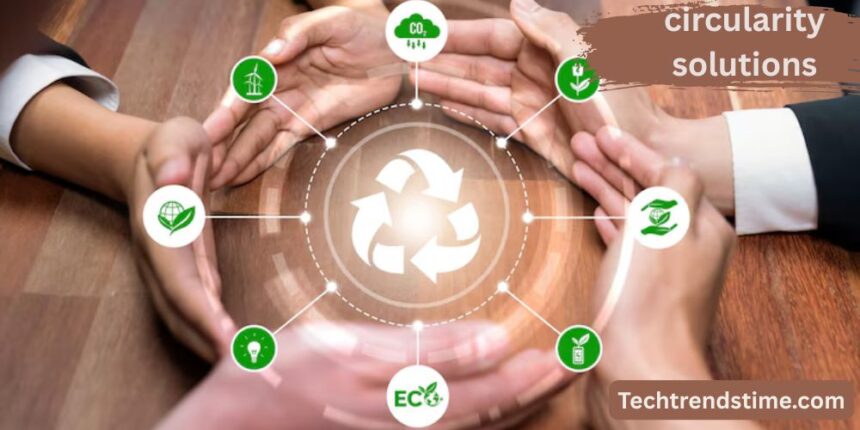Enter circularity solutions. a game-changing way to rethink how we produce, consume, and dispose of goods. Let’s face it—our planet’s running on a ticking clock. Resources are getting stretched thin, landfills are bursting, and climate change is no longer some distant threat. But what exactly are these solutions, and why are they getting so much attention?
What Is Circularity?
Circularity solutions is all about creating closed-loop systems that minimize waste, keep materials in use, and regenerate natural systems. Unlike the traditional “take-make-waste” model, circular systems aim to be restorative and regenerative by design. It’s sustainability in action—smart, efficient, and forward-thinking. Here’s the deal: the linear economy is broken. We’re draining natural resources and producing waste faster than the Earth can handle. Circularity is our shot at turning this around. It not only helps reduce environmental impact but also fuels economic innovation, strengthens supply chains, and creates new business opportunities.
The Foundation of Circular Economy
Circularity solutions rests on three core pillars: Products are designed from the get-go to minimize waste and pollution. Think recyclable materials, modular parts, and non-toxic substances. From repair and reuse to remanufacturing and resale—keeping stuff in play for as long as possible is key. It’s not just about doing less harm. It’s about actively restoring ecosystems—composting, reforestation, regenerative agriculture, and more.In a linear model, we take resources, make products, and toss them when we’re done. Circular models aim to eliminate that “end-of-life” by designing products to be reused, repaired, or recycled endlessly. It’s like trading in a one-way ticket for a r ound-trip pass.
Types of Circularity Solutions
Instead of owning products, consumers pay to use them. Think bike-sharing, car subscriptions, or leased appliances. Businesses retain ownership and responsibility for recycling or refurbishing. These systems recover valuable materials from waste—like turning food scraps into compost or extracting metals from old electronics. Airbnb, Uber, and tool libraries are perfect examples. Sharing underused assets reduces waste and increases efficiency. A supply chain built with circularity in mind focuses on using sustainable inputs, reusing outputs, and designing logistics that minimize emissions and waste. Instead of dumping broken products, companies rebuild and upgrade them for resale. It’s like giving tech and machinery a second life.
Industries Embracing Circularity
Brands like Stella McCartney and Eileen Fisher are using recycled fabrics, offering clothing repair services, and embracing zero-waste designs. Tech companies are refurbishing devices, offering trade-ins, and designing gadgets that are easier to repair and upgrade. Modular buildings, reclaimed materials, and green designs are redefining how we build spaces. From regenerative farming to compostable packaging and surplus food apps—food is getting a circular makeover too.
Real-World Examples of Circularity
Patagonia’s Worn Wear program repairs and resells old gear to extend product life and keep items out of landfills. Rather than selling light bulbs, Philips sells “light”—installing and maintaining energy-efficient lighting systems for businesses. IKEA’s buy-back programs and recycled-material collections are helping the giant embrace a greener footprint. Less waste, fewer emissions, and decreased dependence on virgin materials—circularity is a major win for the planet. Circular models create new revenue streams, jobs, and innovation opportunities in logistics, design, and digital tech. Brands that offer circular options—repairs, buy-back, leasing—often see stronger loyalty and repeat business.
Challenges Facing Circularity Adoption
Not all materials are easy to recycle or refurbish. We need better tech to make circularity seamless and scalable. Inconsistent regulations across regions can slow progress. Clear policies and incentives are essential for momentum. Many consumers are still hooked on convenience and newness. It takes education and cultural shift to embrace reuse and repair. AI optimizes supply chains, predicts waste patterns, and helps in designing sustainable products. Blockchain tracks products from cradle to grave, ensuring ethical sourcing and waste accountability. Sensors and smart devices help monitor resource use in real time, improving efficiency and reducing waste.
Role of Government and Policy Makers
Governments can offer tax breaks or grants to businesses embracing circularity—making the transition easier and faster. Laws banning single-use plastics, mandating recycling, and supporting eco-labeling can fast-track circular adoption. Start by mapping your product lifecycle and identifying waste points or improvement areas. Build with disassembly, repairability, and reuse in mind. Partner with recyclers and refurbishers. Employees, suppliers, and customers all play a role. Offer training, incentives, and clear communication.
How Consumers Can Support Circularity solutions
They’re cheaper, eco-friendly, and often just as good as new. Win-win. Put your money where your values are. Support companies that walk the circular talk. Know what goes where. One wrong item can ruin a whole recycling batch. Think biodegradable electronics, circular fashion tech, and closed-loop packaging systems. Innovation is just heating up. More businesses and governments are teaming up to make circularity mainstream through initiatives like the Ellen MacArthur Foundation.
FAQs About circularity solutions
What are the most common circularity solutions today?
Product-as-a-Service models, recycling and resource recovery systems, and remanufacturing are some of the most widely adopted circular strategies.
How does the circular economy benefit the environment?
It reduces waste, pollution, and the extraction of raw materials, helping to lower greenhouse gas emissions and conserve biodiversity.
Can small businesses adopt circularity models?
Absolutely. From offering repairs to using recycled packaging, even small steps can make a big difference—and save money too.
What role does technology play in enabling circularity?
Tech like AI, IoT, and blockchain enhance transparency, efficiency, and innovation in designing, tracking, and optimizing circular systems.
How can I start living more circularly as a consumer?
Buy less, choose second-hand or refurbished, recycle properly, and support brands that value sustainability.
Conclusion
Circularity solutions isn’t just a buzzword—it’s the blueprint for a sustainable, smarter, and more resilient future. From individuals to massive corporations, we all have a role to play. The good news? The tools, technology, and motivation are already here. Now it’s about action. Ready to jump on the circular train?


